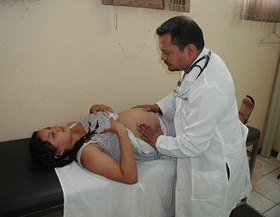Prenatal visit
| Prenatal care | |
|---|---|
| Intervention | |

A doctor performs a prenatal exam.
|
Prenatal care, also known as antenatal care is a type of preventive healthcare with the goal of providing regular check-ups that allow doctors or midwives to treat and prevent potential health problems throughout the course of the pregnancy while promoting healthy lifestyles that benefit both mother and child. During check-ups, pregnant women will receive medical information over maternal physiological changes in pregnancy, biological changes, and prenatal nutrition including prenatal vitamins. Recommendations on management and healthy lifestyle changes are also made during regular check-ups. The availability of routine prenatal care, including prenatal screening and diagnosis, has played a part in reducing maternal death rates and miscarriages as well as birth defects, low birth weight, neonatal infections and other preventable health problems.
The World Health Organization (WHO) reported that in 2015 around 830 women died every day from problems in pregnancy and childbirth. Only 5 of the women who died lived in high income countries, the rest of the women lived in low income countries.
The WHO recommends that pregnant women should all receive four antenatal visits to spot and treat problems and give immunizations. Although antenatal care is important for improving the health of the mother and baby, many women do not receive four visits.
There are many ways of changing health systems to help women access antenatal care such as new health policies, educating health workers and health service re-organisation3. Community interventions to help people change their behavior can also play a part. Examples of these interventions are: media campaigns reaching many people, enabling communities to take control of their own health, informative-education-communication interventions or financial incentives. A review looking at these interventions found that one intervention helps improve the number of women receiving antenatal care. However interventions used together may reduce baby deaths in pregnancy and early life, lower numbers of low birth weight babies born and improve numbers of women receiving antenatal care.
...
Wikipedia
